TALONAVICULAR JOINT ARTHRITIS
Robert H. Sheinberg, D.P.M., F.A.C.F.A.S., D.A.B.F.A.S.
The pain and swelling to the top and inside of the foot is often due to arthritic changes that have developed across the talonavicular joint.
CAUSES:
- Microtrauma to the midfoot area over a prolonged period of time in a patient that is very flatfooted causes stress and wear and tear to the joint surfaces.
- Major trauma to the midfoot, for example, a motor vehicle accident, can cause injury to the talus or the navicular, causing an irregular joint surface/incongruity which predisposes the area to wear and tear and ultimately arthritis.
- Interruption of the blood supply to the navicular (avascular necrosis).
- A stress fracture to the navicular that is intraarticular.
- A progressive flatfoot deformity causing irregular pressure to the talonavicular joint.
SIGNS AND SYMPTOMS:
- Progressive loss of motion to the foot in trying to turn the foot down and in or up and out.
- Swelling across the top and inside of the foot along the joint line.
- Pain and tenderness to palpate the arthritic region.
- Stiffness upon arising in the morning to weightbear that may loosen to some degree in the early part of the morning but get progressively worse the more you are on it.
- Deep ache into the top inside of the foot even off weight-bearing at the end of the day.
- Possible loss of the longitudinal arch on weight bearing (flatfoot).
X-RAYS:
- Loss of joint space in the talonavicular joint region.
- Irregular joint surface.
- Spurring present on the top of the joint.
TREATMENT:
- It is important to identify injury to the joint as early as possible.
- Pain, limitation of motion and early arthritic changes may be helped by a period of immobilization in a cast followed by rehabilitation to help restore strength, stability, and range of motion back to the joint. This would often be followed by an orthotic device to go into the patient's shoes to give support to the region.
- If bone spurring is causing pain, limiting movement to the joint, then the spurs can be resected to provide in some cases temporary or more permanent pain relief.
- If the joint surfaces appear irregular, reconstructive osteotomies to realign the joint may be helpful if the arthritis is not too advanced.
- In advanced stages, surgery to fuse the joint will eliminate the pain and allow pain-free ambulation. Fusion of this joint does limit the foot turning down and in and up and out, which may preclude activities on an uneven surface. However, during walking or typical day-to-day activities will allow complete resolution of the pain.
The following x-rays demonstrate severe arthritis of the talo-navicular joint with joint space diminishing, subchondral sclerosis, and changes in the shape of the bone to abnormal wear. this condition is very painful with weight-bearing activities because this area for most feet depending on the arch height bears a significant amount of impact in the center of the foot.
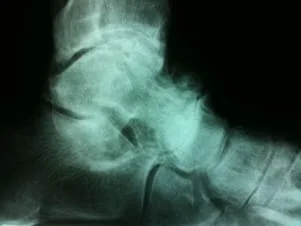

Flatfoot with talonavicular arthritis before and after talonavicular fusion with the subtalar implant
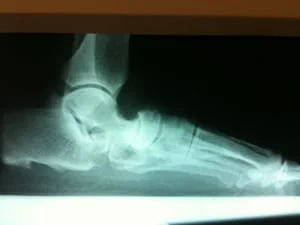
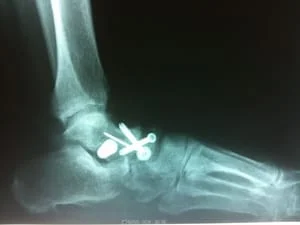
In advanced stages, surgery to fuse the joint will eliminate the pain and allow pain-free ambulation. Fusion of this joint does limit the foot turning down and in and up and out, which may preclude activities on an uneven surface. However, during walking or typical day-to-day activities will allow complete resolution of the pain.
Preop and Postop TN Fusion for End-Stage TN Arthritis
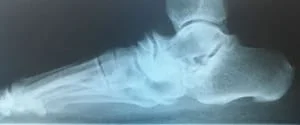
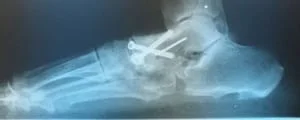
The following x-ray is a dorsal-plantar view of post-surgical fusion (arthrodesis) of the joint with the main goal is to eliminate pain.
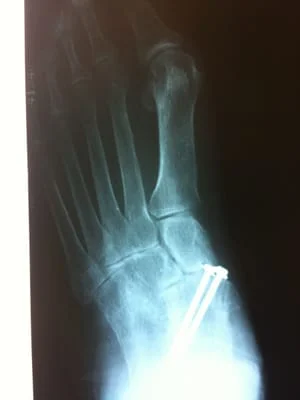
The following is a post-surgical x-ray of fusion of the talo-navicular and subtalar joint.
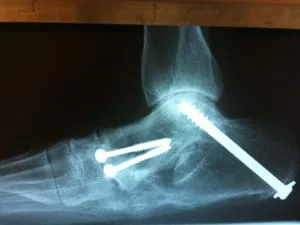
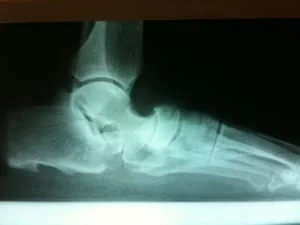
Pic of flatfoot with TNJ arthritis treated with triple arthrodesis
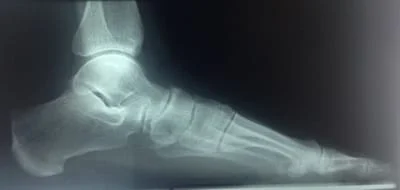
Joints are realigned and in excellent positioning
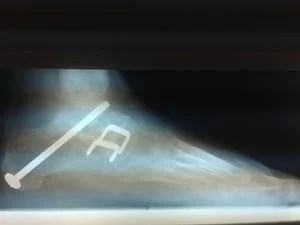
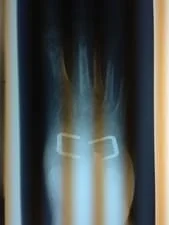
Pic of Isolated Talonavicular Fusion

